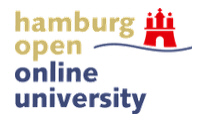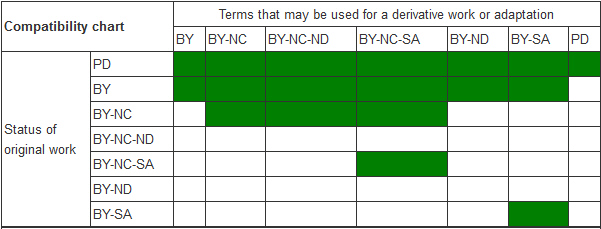
Aircraft Design -
an Open Educational Resource (OER)
for Hamburg Open Online University (HOOU)
On this page you find information to get the OER "Aircraft Design" organized (not the aircraft design facts themselves).
Please go to the
main page
to find the Aircraft Design lecture notes.
1 Selected Links related to "Aircraft Design" for HOOU@HAW
2 Background / Fundamentals
2.1 HOOU
2.2 Definitions
Off the main focus:
2.3 Consortia & Platforms for OER
2.4 OER for Aeronautical Engineering
2.5 Online Courses about OER
3 Choosing the Right CC License for My HOOU OER
Choosing a CC License is normally done on the CC page
Choose a License.
The Creative Commons Australia web page may provide more insight to find your CC license:
Which Creative Commons licence is right for me? - Viewer
Which Creative Commons licence is right for me? - Poster (PDF)
3.1 My Personal Reasons for CC BY-NC-SA
For everyone it is a personal choice. Here are my personal reasons to decide for CC BY-NC-SA for an OER (for a research paper I go for CC BY):
- CC: For me it is ok, if other people are copying and distributing my content without asking my permission everytime.
For this reason, I will use a CC license.
It would just be too much work writing so many e-mails to people requesting some reuse rights -
people I do not know and will not have the time to get more in contact with.
- BY: I would like to be mentioned as the author of my work. This is good practice in science anyway. This leads to BY.
- Not ND: I have included work from others in my OER. It is only fair to allow also others to do the same with my work.
For this reason, it is not a problem for me if others are changing (correcting, improving, extending) and adapting my content.
I am happy if others remix my content with their own content and with the content of third parties.
After all, this is what science is about. This means my work will NOT be ND. -----
It is a totally different topic (and remains to be seen), how much help I can provide for others to easily get hold of my content.
E.g. my files in PDF are out there, they are not password protected. It is thus possible to copy text and graphics from them.
I may be able to provide my original Word files (DOC) also with the graphics in their original resolution.
These files convert also well to Libre Office files (ODT) - with the exception of the equations
(Libre Office is using - a better - unfortunately an incompatible equation editor).
- NC: I give away my work without charging for it, I would have a problem discovering later that others make money with my work.
For this reason, I give my work away only for NonCommercial use (NC).
- SA: If people remix work they have to obey the reuse rights given to them for each building block.
E.g. if an author includes a CC BY-NC into his/her work the final work may not be sold,
because this would be in violation of the CC BY-NC. It follows that specifying CC BY-NC will force other also to use NC.
That is ok for me, that is what I intend. But others could be more restictive than I am.
Imagine an author who produces a new work 90 % my work and only 10 % brilliant ideas added.
He/she may decide not to use a public licence (CC) at all. So, if I come across this new work on the Internet (of course very interesting for me),
I would have no means to do anything with this new work except to read it (or to ask the author for permission).
Honestly, if this would happen, I would be annoyed. I have certain ideas how our world should be - an open place -
I would like to use my possibilities a little to shape the world towards where I want it to be.
For this reason, I would like to tell others: "if you take from my generous offer, please act in a similar way". This leads for me to Share Alike - SA.
Note: If I would specify only CC BY-NC (without SA) someone with the intention to use CC could still make it a CC BY-NC-ND.
With this I also could not use the interesting added 10 % for my next work.
3.2 MIT Open Course Ware is Using CC BY-NC-SA
MIT OpenCourseWare is also using CC BY-NC-SA. Read their
Terms of Use.
3.3 License Compatibility
If I choose CC BY-NC-SA, I have the largest pool of works with other CC licenses to include:
In addition to PD I can take works with BY, BY-NC, and BY-NC-SA (see Figure 3.1).
A final work intended for CC BY-NC-SA allows 4 other CC licenses to be included - more than any other license!
ND licenses do not allow to go along with my work anyway (or any other work). The only license really left out is CC BY-SA.
According to the logic applied by CC, it is such that CC BY-SA wants its license to stay and that is to allow ("by all means") commercial use.
This is in contradiction to my intention NOT to allow commercial use (i.e. to have it NC). See
here
for details. The very unfortunate thing about this incompatibility is that I can not use sources from Wikipedia (which is CC BY-SA).
If it would be desperately important for me to use material from Wikipedia, I would be forced to also use CC BY-SA.
This is a decision to be made and depends how much material from Wikipedia would be important to include.
Sure, it is easy to go to Wikipedia and take from there, but it is also possible to use Google and tell Google what resources to show
depending on the CC license.

Figure 3.1: The green boxes indicate where compatibility exists between licenses.
When modifying a work licensed under the license identified in the lefthand column,
you may license the adaptation under one of the licenses indicated on the top row if the corresponding box is green.
White boxes indicate those licenses that you should not use for the adapted work.
In the absence of an applicable copyright exception or limitation, you can never adapt or include works that are licensed ND.
Source:
David Wiley:
Introduction to Openness in Education
(CC BY)
3.4 Including Material with Copyright into an OER
There are 3 ways to do it:
- Material can be included as a short citation. This is normal scientific way of working.
- Material can be included as a link together with the statement that this linked material is not part of the public license given to the OER.
- Material can be included under Fair Use with the statement that this material is not part of the public license given to the OER.
See the MIT OCW
FAQ: Fair Use and the
The Code of Best Practices in Fair Use for OpenCourseWare which is summarized
here.
4 How to Set Up Open Course Ware
- The most simple for of Open Course Ware is a chronological reading lists and discussion topics. We can add to this! See the following points.
- Homework problems
- Solutions to homework problems
- Exams
- Solutions to exams
- Lecture notes
- Interactive web demonstrations in Java
- Interactive software tools that run after being downloaded
- Complete textbooks (written by the professor teaching the online course) available as part of the course
- Complete Open Textbook available on the Internet also independent of the course
- Streaming video lectures (also available for download)
- Streaming explanation video (also available for download)
- ... (this list does not intend to be conclusive)
5 Experimenting with My New YouTube Channel
ProfScholz @ YouTube
and the short link to the channel:
http://YouTube.ProfScholz.de
My YouTube Playlists:
STAND: 31 May 2017
AUTHOR: Prof. Dr. Scholz
IMPRESSUM (PDF)

 Prof. Dr. Scholz
Prof. Dr. Scholz
 Aircraft Design and Systems Group (AERO)
Aircraft Design and Systems Group (AERO)
 Aeronautical Engineering
Aeronautical Engineering
 Faculty of Aviation and Automotive Systems
Faculty of Aviation and Automotive Systems
 Hamburg University of Applied Sciences
Hamburg University of Applied Sciences







 Prof. Dr. Scholz
Prof. Dr. Scholz
 Aircraft Design and Systems Group (AERO)
Aircraft Design and Systems Group (AERO)
 Aeronautical Engineering
Aeronautical Engineering
 Faculty of Aviation and Automotive Systems
Faculty of Aviation and Automotive Systems
 Hamburg University of Applied Sciences
Hamburg University of Applied Sciences